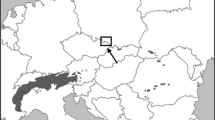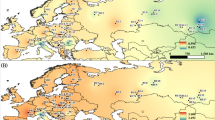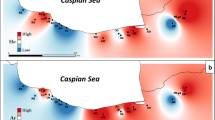Abstract
Recent changes in environmental conditions in populations of peat-bog pine (Pinus uliginosa Neumann) caused rapid decline or even extinction of the species in several stands in Central Europe. Conservation strategies forP. uliginosa require information about the evolutionary history and genetic structure of its populations. Using isozymes we assessed the genetic structure ofP. uliginosa from four isolated stands in Poland and compared the results to genetic structures of other closely related pine species including eight populations ofPinus mugo, ten ofPinus sylvestris and one ofPinus uncinata. The level of genetic variability ofP. uliginosa measured by the mean number of alleles per locus and average heterozygosity was similar to others related toP. uliginosa taxa from the reference group but it differs among populations. High genetic similarity was found between two populations ofP. uliginosa from Low Silesian Pinewood. The populations were genetically distinct as compared to other populations includinglocus classicus of the species from the peat bog at Batorów Reserve. Very low genetic distance (Dn = 0.002) and small genetic differentiation (GST = 0.003) were found betweenP. uliginosa andP. mugo in the sympatric populations of the species from Zieleniec peat bog suggesting the ongoing natural hybridisation and genetic contamination of peat-bog pine from this area. Some evidence for skew in allele frequency distribution potentially due to recent bottleneck was found in population from Low Silesian Pinewood. The analysed open pollinated progeny derived from twoP. uliginosa stands from Low Silesian Pine-wood showed the excess of homozygotes as compared to the maternal trees indicating high level of inbreeding (F = 0.105,F = 0.081). The results are discussed in the context of evolution ofP. uliginosa populations, taxonomic relationships between the analysed species and conservation strategies for active protection of peat-bog pine.
Similar content being viewed by others
References
Bączkiewicz A, 1995. Biometrical study of some individuals chosen from Pinus mugo Turra populations in the peat bog “Bór na Czerwonem”. Acta Soc Bot Pol 64: 71–80.
Bobowicz MA, 1990. Hybrids ofPinus mugo Turra ×Pinus sylvestris L. from “Bór na Czerwonem” Reserve in the Nowotarska Valley (in Polish). Wyd. Naukowe UAM Poznań.
Boratyńska K, Boratyński A, Lewandowski A, 2003. Morphology ofPinus uliginosa (Pinaceae) needles from populations exposed to and isolated from the direct influences ofPinus sylvestris. Bot J Lin Soc 142: 83–91.
Boratyński A, 1994. Protected and worth protection trees and shrubs of the Polish part of the Sudety Mountains and the Sudety Foothills. 7.Pinus mugo Turra andPinus uliginosa Neumann. (in Polish). Arboretum Kórnickie 39: 63–85.
Boratyński A, Boratyńska K, Lewandowski A, Gołąb Z, Kiciński P, 2003. Evidence of the possibility of natural reciprocal crosses betweenPinus sylvestris andP. uliginosa based on the phenology of reproductive organs. Flora 198: 377–388.
Christensen KI, 1987. Taxonomic revision of the Pinus mugo complex and P. × rhaetica (P. mugo × sylvestris) (Pinaceae). Nord J Bot 7: 383–408.
Corander J, Sirén J, Arjas E, 2008. Bayesian Spatial Modelling of Genetic Population Structure. Computation Stat 23: 111–129.
Cornuet JM, Luikart G, 1996. Description and power analysis of two tests for detecting recent population bottlenecks from allele frequency data. Genetics 144: 2001–2014.
Danielewicz W, Zieliński J, 2000. Protection of thePinus uliginosa Neumann on the area of the Low Silesian Pinewood. (in Polish). Przegląd Przyrodniczy XI 2–3: 113–124.
Excoffier L, Laval G, Schneider S, 2005. Arlequin ver. 3.0: An integrated software package for population genetics data analysis. Evol Bioinform Online 1: 47–50.
El-Kassaby YA, 1991. Genetic variation within and among conifer populations: review and evaluation of methods. In: Fineschi S., Malvolti M. E., Cannata F., Hattemer H. H, eds. Biochemical markers in the population genetics of forest trees. Acad Pub Hague: 63–74.
Frankham R, 1997. Do island populations have less genetic variation than mainland populations? Heredity 78: 311–327.
Gołąb Z, 1999.Pinus uliginosa Neumann in Wielkie Torfowiska Batorowskie (The Great Batorowskie Peatbog) in the Stołowe Mountains. (in Polish). Szczeliniec 3: 41–48.
Goncharenko GG, Silin AE, Padutov VE, 1995. Intra-and interspecific genetic differentiation in closely related pines fromPinus subsectionSylvestres (Pinaceae) in the former Soviet Union. Plant Syst Evol 194: 39–54.
Hamrick JL, Blanton HM, Hamrick KJ, 1989. Genetic structure of geographically marginal populations of ponderosa pine. Am J Bot 76: 1559–1568.
Hedrick PW, 1974. Genetic similarity and distance: comments and comparisons. Evolution 29: 362–366.
Jain SK, Workman PL, 1967. The use of generalized F-statistics in the theory of inbreeding and selection. Nature 214: 674–678.
Kärkkäinen K, Savolainen O,1993. The degree of early inbreeding depression determines the selfing rate at the seed stage: model and results fromPinus sylvestris (Scots pine). Heredity 71: 160–166.
Kliman RM, Andolfatto P, Coyne JA, Depaulis F, Kreitman M, 2000 The population genetics of the origin and divergence of theDrosophila simulans complex species. Genetics 156: 1913–1931.
Kormutak A, Ostrolucka M, Vookova B, Petrova A, Feckova M, 2005. Artificial hybridization ofPinus sylvestris L. andPinus mugo Turra. Acta Biol Cracov Bot 47/1: 129–134.
Lauranson-Broyer J, Krzakowa M, Lebreton PH, 1997. Reconnaissance chimio-systematique et biometrique du pin de tourbierePinus × uliginosa (Neumann). C R Acad Sci Paris, Sci de la vie. 320: 557–565.
Lewandowski A, Boratyński A, Mejnartowicz L, 2000. Allozyme investigations on the genetic differentiation between closely related pines —Pinus sylvestris, P. mugo, P.uncinata, andP. uliginosa (Pinaceae). Plant Syst Evol 221: 15–24.
Lewandowski A, Samoćko J, Boratyńska K, Boratyński A, 2002. Genetic differences between two Polish populations ofPinus uliginosa, compared toP. sylvestris andP. mugo. Dendrobiology 48: 51–57.
Lewandowski A, Burczyk J, Wachowiak W, Boratyński A, Prus-Głowacki W, 2005. Genetic evaluation of seeds of highly endangeredPinus uliginosa Neumann from Węgliniec Reserve for ex-situ conservation program. Acta Soc Bot Pol 74: 237–242.
Lewandowski A, Dering M, 2006. Crossability betweenPinus uliginosa and its putative parental speciesPinus sylvestris andPinus mugo. Silvae Genet 55: 52–54.
Luikart G, Cornuet JM, 1998. Empirical evaluation of a test for identifying recently bottlenecked populations from allele frequency data. Conserv Biol 12: 228–237.
Marcysiak K, Boratyńska K, Mazur M, 2003. Variability ofPinus uliginosa cones from the peat-bog in Węgliniec. Dendrobiology 49: 43–47.
Muona O, Szmidt AE, 1985. A multilocus study of natural populations ofPinus sylvestris. Lect Notes Biomath 60: 226–240.
Nei M, 1972. Genetic distance between populations. Am Nat 106: 283–292.
Nei M, Roychoudhry AK, 1974. Sampling variances of heterozygosity and genetic distance. Genetics 76: 379–390.
Nei M, 1987. Molecular Evolutionary Genetics. Columbia University Press, New York.
Neumann C, 1837. Über eine auf den Seefeldern bei Reinerz u. einigen ähnlichen Gebirgsmooren der königl. Oberförsterei Karlsberg in der Graftschaft Glatz vorkommende noch unbeschrieben Form der Gattung Pinus. — Jahresber. Schlesische Gesellschaft für Vaterländische Kultur 11: 52–57.
Petit RJ, Bodénès C, Ducousso A, Roussel G, Kremer A, 2004. Hybridization as a mechanism of invasion in oaks. New Phytol 161: 151–164.
Prus-Głowacki W, Szweykowski J, 1979. Studies on antigenic differences in needle proteins ofPinus sylvestris L.,P. mugo Turra,P. uliginosa Neumann andP. nigra Arnold. Acta Soc Bot Pol 48: 217–238.
Prus-Głowacki W, Szweykowski J, 1983. Studies on isoenzyme variability in populations ofPinus sylvestris L.,Pinus mugo Turra,Pinus uliginosa Neumann and individuals from a hybrid swarm population. B Sci Amis Poznań 22: 107–122.
Prus-Głowacki W, Bujas E, Ratyńska H, 1998. Taxonomic position ofPinus uliginosa Neumann as related to other taxa ofPinus mugo complex. Acta Soc Bot Pol 67: 269–274.
Rudin D, Ekberg I, 1978. Linkage studies inPinus sylvestris using macro-gametophyte allozymes. Silvae Genet 27: 1–2.
Shea KL, Furnier GR, 2002. Genetic variation and population structure in central and isolated populations of balsam fir,Abies balsamea (Pinaceae). Am J Bot 89: 783–791.
Siedlewska A, 1994. Isoenzymatic differentiation in putative hybrid swarm population (Pinus mugo Turra ×P. sylvestris L.) from “Torfowisko Zieleniec” peat-bog. Acta Soc Bot Pol 63: 325–332.
Siedlewska A, Prus-Głowacki W, 1995. Genetic structure and taxonomic position ofPinus uliginosa Neumann population from Wielkie Torfowisko Batorowskie in Stołowe Mts. (locus classicus). Acta Soc Bot Pol 64: 51–58.
Slatkin M, 1985. Rare alleles as indicators of gene flow. Evolution 39: 53–65.
Szmidt AE, Yazdani R, 1984. Electrophoretic studies of genetic polymorphism of shikimate and 6-phosphogluconate dehydrogenases in Scots pine (Pinus sylvestris). Arboretum Kórnickie 29: 63–72.
Wachowiak W, Lewandowski A, Prus-Głowacki W, 2005a. Reciprocal controlled crosses betweenPinus sylvestris andP. mugo verified by a species-specific cpDNA marker. J Appl Genet 46: 41–43.
Wachowiak W, Celiński K, Prus-Głowacki W, 2005b. Evidence of natural reciprocal hybridisation betweenPinus uliginosa andP. sylvestris in the sympatric population of the species. Flora 200: 563–568.
Wachowiak W, Prus-Głowacki W, 2008. Hybridization processes in sympatric populations of pinesPinus sylvestris L.,P. mugo Turra andP. uliginosa Neumann. Plant Syst Evol 271: 21–40.
Wimmer F, 1837. Über die Zapfen vonPinus silvestris, pumilio unduliginosa. Verh Bot Sect, Übersicht d. Arb. U. Veränd. der Schlesischen Ges. f. Vaterländ. Kultur, Breslau 1837–1840: 93–98.
Yazdani R, Rudin D, 1982. Inheritance of fluorescence esterase and B-galatosidase, in haploid and diploid tissues ofPinus sylvestris L. Hereditas 96: 191–194.
Zarzycki K, Kaźmierczakowa R, 1993. The Polish Red Data Book of Plants. (in Polish). Kraków 1993.
Author information
Authors and Affiliations
Corresponding author
Rights and permissions
About this article
Cite this article
Wachowiak, W., Prus-Głowacki, W. Different patterns of genetic structure of relict and isolated populations of endangered peat-bog pine (Pinus uliginosa Neumann). J Appl Genet 50, 329–339 (2009). https://doi.org/10.1007/BF03195691
Received:
Accepted:
Issue Date:
DOI: https://doi.org/10.1007/BF03195691




